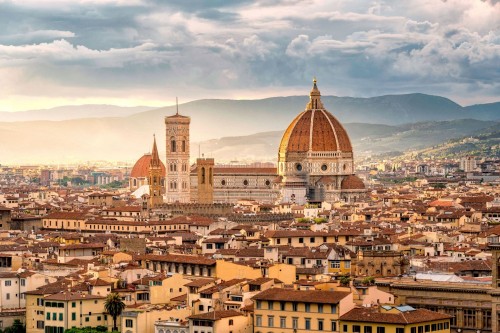Italy
Hidden Florence (The Arts, History)
Explore the Vasari Corridor in Florence. For the museum only, guide Alessandra Marchetti (+39 3473869839; alessandramarchettitours@gmail.com);
Hidden Art in Florence
Perched above the ancient shops lining the Ponte Vecchio in Florence is part of a Renaissance passageway that runs half a mile from the Palazzo Vecchio, north of the Arno, to the gardens of the Pitti Palace, south of the river. You can easily look at its tiny barred windows and red-tiled roof without ever knowing how bizarre and remarkable it is. The passageway houses the world's largest collection of self-portraits by a galaxy of great artists (and, incidentally, provides some of Florence's best views). But getting inside is almost as tough as it was back in 1565, when the structure was commissioned by Cosimo de Medici, all-powerful patron of the arts and the tyrannical ruler of Tuscany. Cosimo, who had many enemies, wanted to be able to walk between his workplace and his residences safely and invisibly, and to have a means of escape in case of an uprising. So he had architect Giorgio Vasari build the passageway, now known as the Vasari Corridor. (Cosimo didn't like the stench from the butchers' shops then lining the Ponte Vecchio, so he replaced them with goldsmiths, which is why the bridge is home to so many gold traders today.)
The Vasari Corridor is now under the care of the Uffizi Gallery. Once in a rare while, organized groups of thirty are allowed to visit, but timing your trip to coincide with a tour and securing a spot is a major logistical challenge. What does it take to get inside on your own, and is it worth it? To find out, I called several travel agents who specialize in Italy. One told me access was impossible. Another said that it was possible but not worth the cost because "the art is nothing to crow about." The rest claimed that it was both possible and worth it. Eventually, I signed up with the first travel agent who managed to gain the necessary permission from the Italian authorities.
The person who actually secured the permission, it turned out, was my gem of a guide, a charming art historian named Alessandra Marchetti. A friend of hers (who is also a former art history professor) conveniently heads the office at the Uffizi that determines who gets to see the corridor.
Nowadays the passageway is accessed from the Uffizi's second floor—a busy hallway with an enormous wooden door that a security guard was waiting to unlock for Alessandra and me. In an instant, we traded the teeming museum for a silent tunnel where I was the only tourist.
For me, the thrill of the Vasari Corridor actually had little to do with its art (the Uffizi's masterpieces are in the main building, of course—not in the corridor). The thrill was how the passageway made Florentine history come to life in such a visceral way. As the tunnel wound this way and that, growing progressively narrower, darker, and more rough-hewn, I felt like I was walking back in time. From the passageway, you can see outside without being seen—which reflects both the paranoia and the power of the Medicis, who traversed the city above their subjects' heads, spying on everyone. Today you can peer down into the shops on the bridge, into hotel rooms along the river (I watched guests eating breakfast in a hotel restaurant), and even into Santa Felicita, since the corridor cuts right through the church's balcony. You find yourself standing behind two thronelike chairs in what seems a dark opera box at the rear of a church that is brightly lit; again you sense the power that the Medicis must have felt as they saw without being seen.
The paintings in the corridor were more interesting as a portfolio of artists through the ages than as great art. Peering hard to make out the dimly lit self-portraits of four centuries' worth of masters—from Vasari himself to Rubens, Van Dyck, Velázquez, Ingres, Corot, John Singer Sargent, and Chagall—I began to feel almost surrounded by ghosts. The passageway grows still narrower and darker as it runs through the Oltrarno neighborhood, abutting the walls of Florentine homes. It ends with a blast of light as you exit the Pitti Palace's Boboli Gardens, next to the Buontalenti Grotto. Thanks to Alessandra's clout with the gardens' security guards, the normally locked grotto was opened so that we could meander through this ornamental, fountained enclosure, built in the 1580s and used by courtiers for secret trysts.
The Uffizi's and Alessandra's fees together totaled five hundred dollars. I had been to Florence twice before but had somehow failed to gain the appreciation of Florentine history, and secrecy, that I felt this time around. Which is why, for me, the experience was worth every cent.
